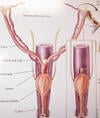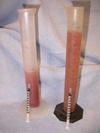 The common, garden-variety spay is one of the most frequently performed surgeries in veterinary medicine. Spay refers to a complete ovario-hysterectomy, the removal of both ovaries and the entire uterus, down to the cervix. The puppy factory (or kitty factory) is completely removed. Cats and dogs have a bi-cornual uterus, meaning it has two long "horns" or tubes, rather than being one big round item. The babies develop in it end-to-end like a string of sausage links.
The common, garden-variety spay is one of the most frequently performed surgeries in veterinary medicine. Spay refers to a complete ovario-hysterectomy, the removal of both ovaries and the entire uterus, down to the cervix. The puppy factory (or kitty factory) is completely removed. Cats and dogs have a bi-cornual uterus, meaning it has two long "horns" or tubes, rather than being one big round item. The babies develop in it end-to-end like a string of sausage links.
People often refer to this as a "routine" surgery. It might be for me, since I do LOTS of them. I know where everything is, I know what I’m going to do first, what I’m going to do second, etcetera. For the patient, there’s nothing routine about it. It’s a once-in-a-lifetime major surgery. You get your tummy cut open and a major organ system removed. Not routine. [At least it wouldn’t be for me. In my average day I strenuously avoid being cut open.] Unlike the old days (meaning, alas, when I first started practice), we use pain medicine, before, during, and after surgery, plus we send it home for three days afterwards. It’s a big deal for the patient.
 This is Callie. She’s about eight years old and recently came to live with new owners. They brought her in to be spayed for two reasons. One, just on the general principle that they didn’t want her shelling out unwanted kittens all over the place. Two, she yowls a lot and has been urinating on the owner’s pillow (and on the owner’s head, should it be on the pillow). They thought that her hormones might be causing this behavior. Hey, they might… or she might just be evil, as some cats are.
This is Callie. She’s about eight years old and recently came to live with new owners. They brought her in to be spayed for two reasons. One, just on the general principle that they didn’t want her shelling out unwanted kittens all over the place. Two, she yowls a lot and has been urinating on the owner’s pillow (and on the owner’s head, should it be on the pillow). They thought that her hormones might be causing this behavior. Hey, they might… or she might just be evil, as some cats are.
While Callie’s physical exam didn’t seem too remarkable, she did seem a bit thin. When we anesthetized her, we found things that we couldn’t detect while she was awake and tense. With her abdomen relaxed, my lovely assistant Shannon felt weird things when she began to prep Callie’s tummy for surgery. An ultrasound scan showed big things full of fluid that shouldn’t be there. On exploration, we found that Callie had an enormous cystic uterus. The specialist called this a "hydrometra" (a uterus full of fluid).
 I won’t show you the gross pictures, but here’s the fluid that we recovered after finishing the surgery. 160cc may not be too meaningful to you, but for purposes of scale, those two little syringes put together would be bigger than the average normal uterus from a cat. Five ounces of fluid from a five pound cat is about like a gallon of fluid from a 110-pound lady. That’s a lot.
I won’t show you the gross pictures, but here’s the fluid that we recovered after finishing the surgery. 160cc may not be too meaningful to you, but for purposes of scale, those two little syringes put together would be bigger than the average normal uterus from a cat. Five ounces of fluid from a five pound cat is about like a gallon of fluid from a 110-pound lady. That’s a lot.
Callie’s doing fine. This is one time when the surgery was more routine for the patient than it was for the surgeon. If you’re not going to raise kittens, get the kitty factory out of there.

